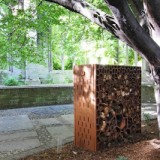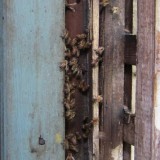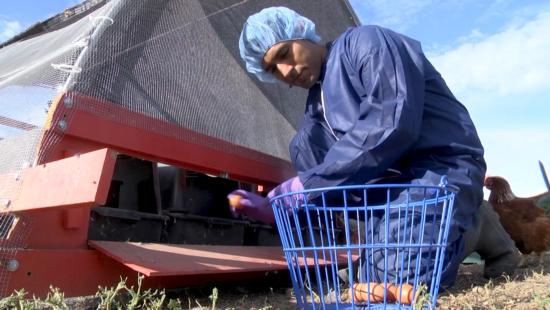
Free bees in my swarm box.
Since 2009, when our beekeeping mentor Kirk Anderson showed up with some bees in a shop vac, I’ve kept our bee stock going and helped other people establish apiaries in just about every way you can. I’ve cut hives out of walls (a lot of work that fails most of the time). I’ve trapped them out (a huge pain in the ass). I’ve captured swarms (easy, but they often take off the next day). The only thing I haven’t done is purchase bees. At about $125 a pop, it’s an expensive option considering they often don’t make it. By far, the best way to get bees is to invite them to settle down on their own. Here’s how to do it.
Build it and they will come
Set up your bee housing (Langstroth hive or top bar hive) and the bees might just move in on their own. It’s happened to me twice now in seven years. You should have your boxes ready to go anyway, since you can never predict the day someone will call with a swarm that needs a home. This readiness applies to tools too. Have all your bee tools in an easily accessible toolbox, always ready to go.
Where to set up your hives is one of the great mysteries of beekeeping. Here in Southern California they seem to prefer some sun and some shade. But I’ve found feral hives both in total shade and full sun. Your results will vary, depending on your climate, but they probably won’t do well in the bottom of a cold canyon or the top of a windy mountain.
 Swarm boxes
Swarm boxes
Instead of setting up a proper hive, bait a bunch of boxes and place them in your yard, in your friends yards and in random places and you might just capture a swarm or two. You can buy or make swarm boxes. Natural beekeeper Michael Bush has estimated that bees show up in around 10% of the swarm boxes he sets up. He also suggests hanging them up around 10 feet high for best results. I like swarm boxes that hold frames so that you can transfer the bees easily to your hive boxes without having to do a cutout.
And guess what? A bee swarm box and a birdhouse are pretty much the same thing. So get friendly with birdhouse enthusiasts.
Baiting swarm boxes
You can buy swarm lure, a kind of synthetic pheromone, but it’s expensive and doesn’t last long. Some folks suggest a cotton swab dipped in lemongrass oil and stuck in a medicine bottle with holes in it. Better, I think, is to mix wax and lemongrass oil and paint that on your frames.
Used equipment that once held bees is also a powerful attractant. Once bees figure out a good space they will come back to it.
Where to put a swarm box
Something that happened to us last week will show you how random and inexplicable bees can be when it comes to occupying a swarm box. I had a swarm box up on top of our shed roof, near our neighbor’s orange trees, because bee swarms have landed there in the past. But even though that box has been up there for years, bees never moved in. So, about a month ago, I finally took the swarm box off the roof and tossed in haphazardly, upside-down, in a large plastic pot that was half filled with chicken litter. I intended to throw the box out at some later date.
Then, a few days later, as a neighbor was telling me about his favorite climbing roses, Kelly called me from the porch, saying there was a”bee situation” going on in the back yard. I ran up the stairs and behind the house to see one of the awe inspiring miracles of nature: a hive moving into their new home–that new home being the upside-down swarm box in the plastic pot half full of dirty chicken litter. Being bloggers, Kelly and I should have whipped out our smart phones to catch some video. Instead, we sat on the patio and watched the swarm buzz around for ten minutes before they settled in the box.
I put a bee suit on (swarms are usually docile, but it’s best to be safe) and took the box out of the pot and righted it carefully, setting it near my established hives. I’m going to give the queen plenty of time to settle in and start laying eggs –at least 28 days–during which time I won’t touch or look at these bees. Since I already have two hives, I’m going to give these bees away. Anyone want bees?
Have you had a swarm move in on its own?





Walker Rollins and Kirk Anderson delivered a four part workshop for beginner beekeepers at Walkers place about 3-4 yrs ago. We learned how to trap a swarm and left with a box, frame and some lemongrass oil in a baggie. I set this in a high tree we have and caught bees 3 days later. Had them ever since. The honey we get from this hive is amazingly good.
Pingback: ruff linkage 201615
I’ve got a couple of general bee questions that I hope you don’t mind me asking here.
I’ve been curious for years about offering space on my acreage for a beekeeper to site a hive. Do people do such things? My location may not be ideal because much of my land is wetland and is re-wilding but I love to encourage more species to live here. It is unlikely that I would be able to manage a hive on my own.
And I wondered what you, as a beekeeper, thought of this issue: http://www.wlox.com/story/31766842/gautier-will-vote-to-approve-a-beekeeping-ordinance Sounds distressing to me because this is the beekeeper’s livelihood and because a good beekeeper can do good for the environment.
Absolutely! There’s a lot of beekeepers who keep their hives on another person’s land. And Los Angeles legalized bees. The planning department put together some common sense “best practices” that include a limit on the number of hives in an urban area (2) as well as some good suggestions for placement that will minimize problems with the neighbors.
Thanks! I will seriously consider contacting a local beekeeper. There are quite a few native plants that flower on my acreage during the course of the year so there would be goodies for bees. Unfortunately, a recent neighborhood fire caused some losses in my yard (including a nice little nesting of Elliot’s Blueberry). I’m hoping for re-growth soon–the Piney Woods are naturally a fire environment, after all.